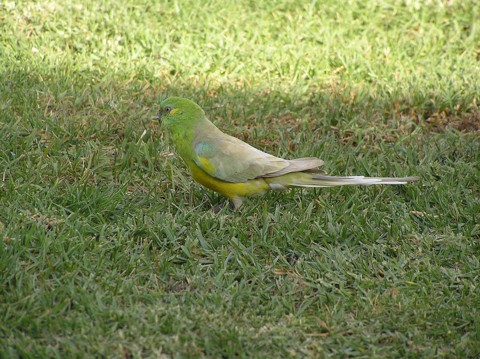Orange Bellied parrot imminent extinction threat
Peter Garrett last week announced $260,000 will be spent on an urgent bid to save the Orange-Bellied Parrot from extinction.
Under the Federal Government plan, captive populations will be boosted and extra feed and nesting options will be provided to encourage the 50 or so parrots left in the wild to breed.

(orange bellied parrot: source Wikimedia Commons).
The Orange-bellied Parrot is a migratory bird, which breeds only in coastal south-west Tasmania and spends the winter in coastal Victoria and South Australia. In Tasmania it occurs in buttongrass moorland interspersed with patches of forest or tea tree scrub.
Ecologist Peter Menkhorst, a spokesman for an existing 15-member recovery team, said the wild population was expected to disappear in the near future, placing enormous pressure on a captive breeding program. He said breeding rates had declined, possibly because of food shortages linked to the drought. However, it is easy to blame “drought” when loss of habitat is the surest way to lose a species!
Auditor General, Mr Des Pearson , in 2009 condemned that the Victorian Government for having few and unreliable statistics and was not fulfilling its legal obligations under the Flora and Fauna Guarantee Act 1988. The report found that efforts to list threatened species and processes had not been matched by efforts to develop action statements, monitor them, or assess their effectiveness.
It is not only orange-bellied parrots that are under threat of extinction. The state’s threatened species list includes some of our most iconic. A 15-year study shows Victorian bird numbers are collapsing throughout central and northern Victoria, with about two-thirds of species, including lorikeets, thornbills, honeyeaters and even kookaburras, declining dramatically in the past five years. (For those in Victoria, you can Take Action Now on the web page).
Bald Hill wind farm in Victoria is notorious for being rejected by then Environment Minister Ian Campbell in 2006 due to the threat to the orange-bellied parrot. This token gesture was later over-ruled!
Ironically, the much-delayed Bald Hills wind, near the Wonthaggi desalination plant, was sold to Japanese interests, Mitsui, for $300 million and will operate from 2011, five years after former environment minister Ian Campbell caved in and belatedly approved the project. As well, Japanese firms have taken a stake in paper (Australian Paper), smallgoods manufacturing (Hans), IT (Kaz Group) and the housing sector (Payce Consolidated). Foreign investors are not likely to be interested in Australian biodiversity or species extinctions!
Water Minister Tim Holding dismissed environmental concerns about the desalination plant and said penguins, seals, whales, orange-bellied parrots, giant Gippsland earthworms, hooded plovers and their habitats would not be significantly affected by the project and nearby dinosaur fossils were also safe. That's reassuring from someone who has no environmental expertise or training!
 (saltmarsh coastline typical in Australia source: Wikimedia commons).
(saltmarsh coastline typical in Australia source: Wikimedia commons).
Many coastal habitats, including coastal saltmarsh areas, are often looked upon as 'wasteland' and bulldozed to make way for industrial developments or housing estates. Orange-bellied parrots spend their winters in such coastal saltmarsh, typically on the shores of estuaries and lagoons.
The parrot, which breeds exclusively in a small area on Tasmania's West Coast, was listed as critically endangered in 2006 and it is feared it could now become extinct by 2013.
The main factors contributing to the loss of Orange-bellied Parrot habitat are:
Throwing money at the problem of wildlife extinctions is meaningless unless real effort is made to restore habitat and eliminate current threats. A collapse of our ecosystems is not "only" about loss of iconic wildlife, forever, but indicative of the weakening of our ecosystems - that we all depend on.
Even if the extinction of a parrot species is considered "sustainable", each species has a role in maintaining healthy ecosystems. Extinction is forever, and each loss means we lose a species with intrinsic value, and we have a weakening of our life-support system.

Recent comments